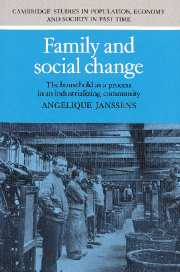Book contents
- Frontmatter
- Contents
- List of figures
- List of tables
- List of appendices
- Preface
- 1 Family and industrialization
- 2 The industrializing context: continuity and change in nineteenth-century Tilburg
- 3 Sources and methods
- 4 Family structure through time
- 5 Family life and the social structure
- 6 Family structure and geographical mobility
- 7 Family and work: the effect of the family economy on the structural characteristics of the household
- 8 Conclusion
- Appendices
- Bibliography
- Index
- Cambridge Studies in Population, Economy and Society in Past Time
3 - Sources and methods
Published online by Cambridge University Press: 05 March 2012
- Frontmatter
- Contents
- List of figures
- List of tables
- List of appendices
- Preface
- 1 Family and industrialization
- 2 The industrializing context: continuity and change in nineteenth-century Tilburg
- 3 Sources and methods
- 4 Family structure through time
- 5 Family life and the social structure
- 6 Family structure and geographical mobility
- 7 Family and work: the effect of the family economy on the structural characteristics of the household
- 8 Conclusion
- Appendices
- Bibliography
- Index
- Cambridge Studies in Population, Economy and Society in Past Time
Summary
In this third chapter I shall discuss the source on which this study is based, the Dutch nineteenth-century population registers, and the quality of the data used for this study. The construction of the different samples used for analysis is outlined and in addition a number of methodological and analytical problems involved in the analysis of longitudinal family histories are dealt with.
Static versus dynamic
Within family history it has become widely accepted that the family should be considered as a dynamic concept. In the last volume of articles produced by the Cambridge Group, Sieder and Mitterauer concluded that the importance of a dynamic approach in the historical study of family and household was no longer in dispute. When studying aspects of family and household the developmental stage of the household has to be taken into account. Unfortunately, the methodological realization of this goal is not always straightforward. Family historians are considerably hampered by the static character of their source material. Historians are mostly forced to rely on census listings which only render a frozen image of the household. As Laslett and Wall put it in their introduction to Household and Family in Past Time: ‘We find ourselves for the most part forced to discuss a process as if it were in fact a state.’ The cross-sectional approach misses the essential processes that produce the particular manifestations of household composition as presented by the census.
- Type
- Chapter
- Information
- Family and Social ChangeThe Household as a Process in an Industrializing Community, pp. 50 - 68Publisher: Cambridge University PressPrint publication year: 1993

